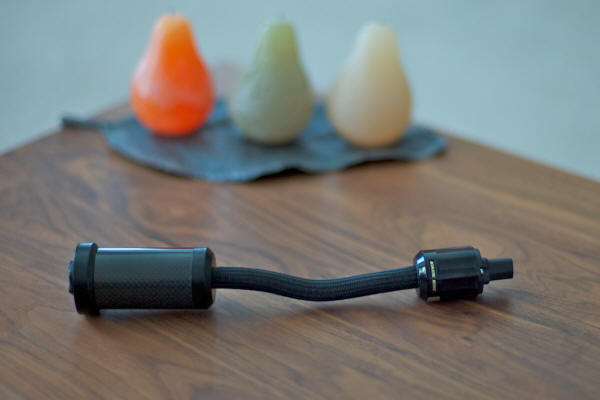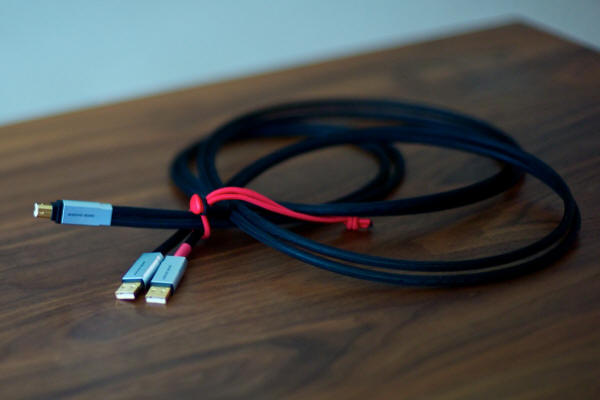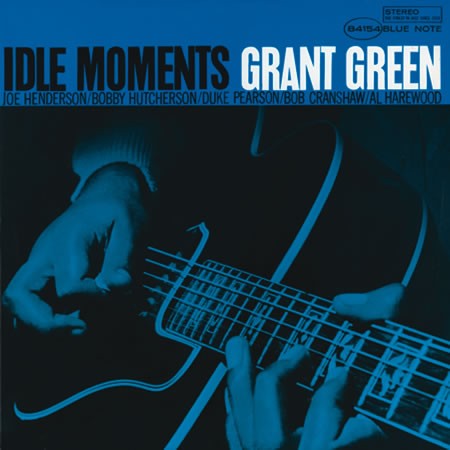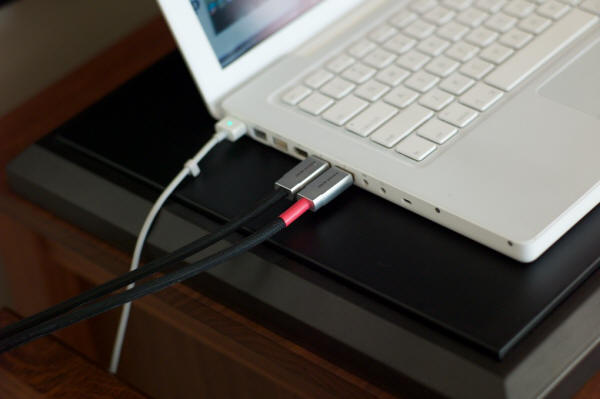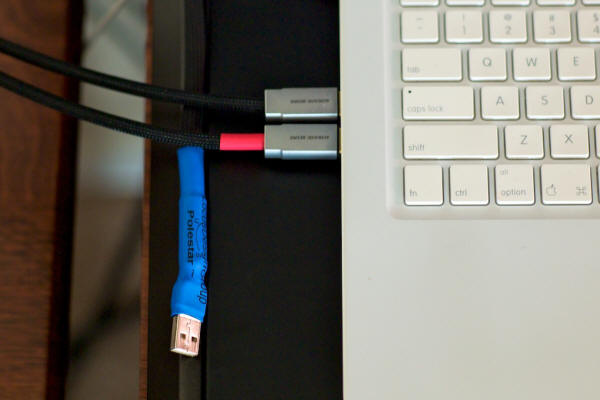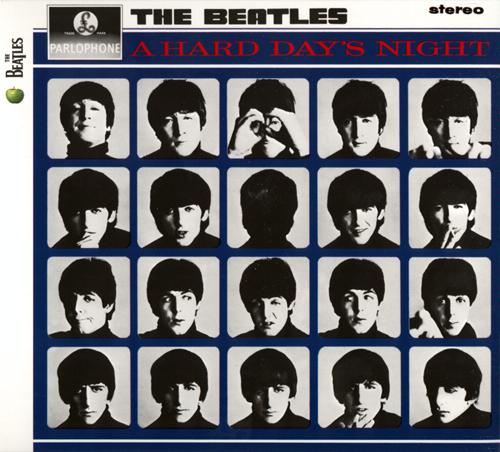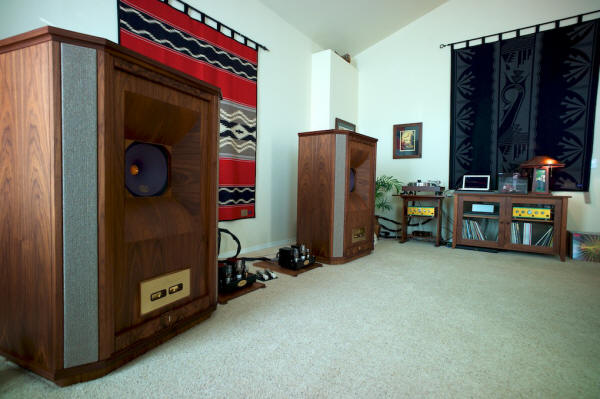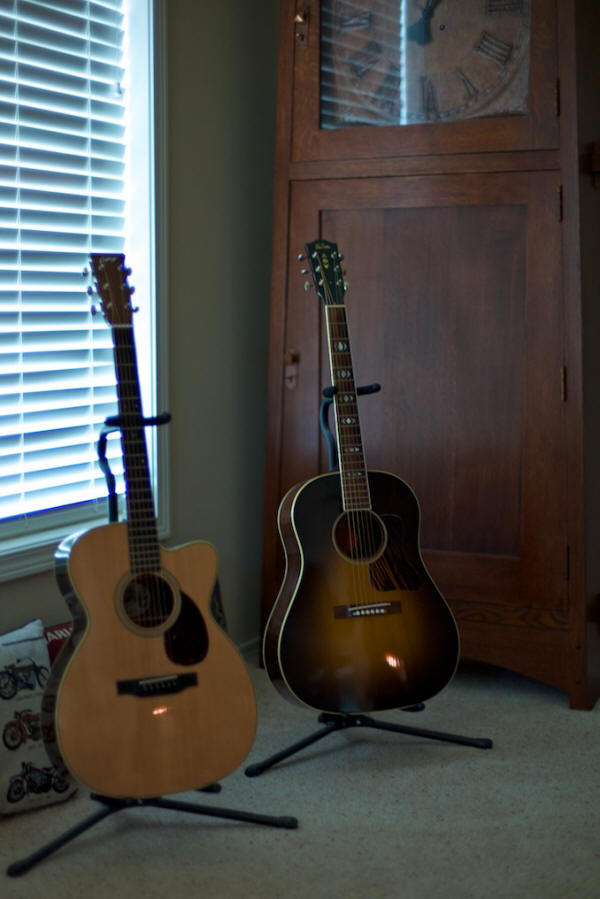|
You are reading the older HTML site
Positive Feedback ISSUE 55
The Acoustic Revive Chronicles - Chapter 9: The
RAS-14 AC Power Conditioner and the USB-1.0SP USB Interconnect
Welcome to the Acoustic Revive Chronicles, Chapter 9. This is the seventh installment of the Acoustic Revive Chronicles here at Positive Feedback Online, with the first three chapters being over at 6Moons. Here's what has taken place so far in the review of the Acoustic Revive audio performance products: Chapter 1 – The RR-77 ultra-low frequency pulse generator. Chapter 2 – The RIQ-5010 & RIQ-5010W quartz Insulators and QR-8 quartz resonators. Chapter 3 – The RCC-24 ground conditioner and the SIP-8F RCA input shorting plugs. Chapter 4 – The RPT-2 & RPT-4 Ultimate Power Distributors and the Power Reference power cables. Chapter 5 – The REM-8 EMF canceller. Chapter 6 – The RWL-3 Acoustic Conditioner panels; the CB-1DB receptacle base plate, the CFRP-1F carbon fiber outlet plate, and the CS-F2 outlet stabilizer. Chapter 6a – Getting Top Performance From Your Digital Media: Shine Ola Optical Disc Cleaner, the Acoustic Revive RIO-5II Negative Ion Generator, and the Acoustic Revive RD-3 Disc Demagnetizer Chapter 7 – The Custom Series loudspeaker stands, the RST-38 & TB-38 quartz under-boards, and the RAF-48 air floating board. Chapter 8 – The Single-Core speaker cables & RCA interconnects, RCI-3 Cable Insulators. As I was going through the past articles of the Chronicles and thinking about all that has taken place it really hit home how well all of the Acoustic Revive products have worked in my Hi-Fi rig, taking it to musical and sonic levels that would just be impossible otherwise. So here are my long-term test results for using Acoustic Revive products in my reference system on a daily basis: They rock! It's really that simple, as these are great products, engineered to perfection, that deliver results that most other accessories can only dream of. As I was going back through the past articles I got a real chuckle thinking about the reader messages I mentioned in Chapter 6: "I get quite a lot of reader e-mail related to the Acoustic Revive lineup. Some of the more entertaining subject lines for those e-mails have read: "A Holy Cr** Experience!" or "Oh My God!" or "F***ing Unbelievable!". Even my jaded fellow reviewers and local audio pals have laid down their own hard-earned long green for Acoustic Revive products after experiencing them, and that doesn't happen all that often with that hard to impress crowd." I'd say that sums up a lot, but I think it is worthwhile to cover the basics that I mentioned in Chapter 6 as well: "Those who have been following the Acoustic Revive Chronicles know all about Mr. Ken Ishiguro and his impressive design work that has created the Acoustic Revive system & room tuning products, but for those who are just tuning in (inadvertent pun) let me provide you a little background primer. Mr. Ken Ishiguro's design goal is provide products through the Acoustic Revive brand that help voice one's Hi-Fi system so that it will play a recording "so that it sounds natural and not as though it is being played back over an electrical device." Those who have been following my writing know that's exactly the kind of products I want in my own system. Or as Jim Smith puts it in his excellent book Get Better Sound, this is the "going for the musical balance before going for the audiophile sound effects" approach (you should get a copy of Jim's book if you haven't already). You can only go so far in achieving a musical balance with careful setup of your home audio system, and beyond that some definitive choices are required in the realm of equipment and accessories. I have found over my years of reviewing Hi-Fi gear that some audio equipment just does not seem to be capable of achieving the sort of natural musical balance I prefer on its own, no matter how careful I am in system setup. Even when set up with the goal of achieving a natural tonal balance in mind, some Hi-Fi gear still sounds overly analytical, mechanical, and too lean. Usually this sort of gear has lots of sound-staging information, presents a big billowing sound-space, and has lots of detail recovery, but it fails to get the relaxed presence, saturated tonal colors, forward momentum, body, musically expressive subtleties, and natural warmth that I hear (and crave) in live music. So with that context in mind, lets get back to Acoustic Revive: Ken-San's design goal of providing products that helps voice one's Hi-Fi system so that it will play a recording "so that it sounds natural and not as though it is being played back over an electrical device" is particularly meaningful to me, and I think, also to those who have a lot invested in a system and want to take it to that next step of natural musicality. I think the Acoustic Revive brand name for these products is spot-on, because they really do help revive the natural acoustic life contained in recorded music. Hopefully by reading through the various Chapters of the Acoustic Revive Chronicles you'll get some ideas about which of these products might best help you get your system moving more in that direction." "Here is a brief summary of what I've learned about the Acoustic Revive products up to now: What I hear the Acoustic Revive products doing primarily in my system is improving the musical attributes of recordings. The timbre, meter, tonality, harmony, beat, tempo, syncopation, and melody all became more convincingly natural and life-like as I've added in different AR products. The overall effect has been to make the music more dramatic, bigger, more exciting, and more entertaining—more like you experience in life—more naturally life-like. Also, I found that in many cases the sonic attributes of recording artifacts improved as well: things like sound-staging, imaging, transparency, perspective, and the sense of recorded space became more tangible and vivid. I must confess that I am not particularly focused on increasing the presence of those type of audiophile-style sound effects in my Hi-Fi rig, as I feel voicing a system specifically for those attributes often does far more damage to the music than it provides benefit from a sound-effects-for-entertainment standpoint. If those recording artifact attributes are improved in such a way that they act as a spice to add a little zest to the music I'm fine with it, but when the spice overpowers the flavor of the dish itself, so to speak, and my attention is drawn away from the music by the sonic artifacts of the recording process, then I'm not ok with it. Fortunately the Acoustic Revive products provide a very nice balance of providing a big dose of improving the musical attributes, with an appropriately sized addition of sonic improvements that spices things up without diminishing the music, with the net effect being that I'm drawn deeper into the music. So all-in-all, the Acoustic Revive products have been winners in my home audio system, and have been getting me ever closer to Ken-San's (and my own) goal of a home audio system that "sounds natural and not as though it is being played back over an electrical device."" The Acoustic Revive RAS-14 AC Power Conditioner
When I pulled the Acoustic Revive RAS-14 AC power conditioner out of the box it took me a little bit by surprise, because it didn't look to me like what I expected a 'power conditioner' to look like. Rather, it looked more to me like a fancier version of an Acoustic Revive power cord, albeit a rather short one, and with a carbon fiber chamber surrounding part of its length, and which was filled with some sort of AC conditioning material. It turns out that RAS-14 AC power conditioner is really more of a hybrid device that melds the performance concepts behind the RPT Ultimate Power Distributors, which use a combination of vibrational dissipation and passive AC filtration achieved through the clever applications of materials science, and the Power Reference power cables, which are an ultra-performance power cable that I have found to make a rather astonishing difference in the performance of my Hi-Fi components. You can read the full scoop about how the RPT UPDs and the Power Reference cables work in Chapter 4. Like the Power Reference power cables, the RAS-14 AC power conditioner is constructed with materials that are picked 'by ear' to provide the best musical performance, and they are hand-crafted in a very laborious process that is similar to that described in detail for the Power Reference cables on the Acoustic Revive web site here. The plug ends of the RAS-14 AC power conditioner are customized Oyaide connectors whose conductive parts have been plated with silver and rhodium, then polished to a mirror-like finish before being cryogenically treated to further improve conductivity. The conductors in the RAS-14 utilize 2.6mm by 2.2mm oval Pure Copper by Ohno Continuous Casting (PCOCC-A) single-core conductors. The 'A' on the PCOCC-A indicates that the conductors have been annealed. PCOCC-A is an ultra-high purity (greater than 8N) single-crystal copper conductor that has been annealed to increase its pliability and conductivity. Acoustic Revive says that they have found that single-core conductors are superior to stranded cables because they do not have an "outbreak of straying electric current and distortion," and importantly, the oval shape of their conductors means they do not have a resonance point, which contributes to a smoother, more transparent, three-dimensional, and articulate sound compared to other kinds of conductors. The conductors are covered in a natural silk dielectric, which Acoustic Revive says gives a more natural and spacious feel to the music than other dielectrics. The silk covered conductors are then covered with Teflon coated flexible copper tubing that provides 100% shielding from RFI, and then the entire power cable assembly part of the RAS-14 AC power conditioner is covered with mesh polyurethane tubing containing embedded carbon particles that provides additional shielding and vibration isolation. Ok, so that's a description of the power cord part of the RAS-14, which Power Reference power cord owners will be familiar with, but let's now go on and talk about the AC power conditioning aspect of the RAS-14, which is also quite interesting for its use of vibrational dissipation and passive AC filtering. The AC conditioner that surrounds the power cord portion of the RAS-14 is a carbon fiber tube like you might find in an ultra-high end bicycle frame, like a Cervelo, that you'd see at the front of the peloton in the Tour de France, Milan-San Remo, or Amstel Gold Race. On my own carbon fiber framed Trek I always marvel at how much the vibration from the road surface to my body is reduced by carbon fiber's ability to damp vibration, and that same vibration damping materials science idea is why a carbon fiber tube was chosen by Acoustic Revive for the RAS-14. On each end of the carbon fiber tube are wood (hickory) end caps, with both being chosen by ear for their ability to damp and break up mechanical vibration pathways which deteriorate sound quality, and for having natural sonic signatures. The inside of this 'AC power conditioner' chassis is filled with a combination of green carborundum powder (the purest form), tourmaline powder, and natural quartz powder. Green carborundum is a man-made compound of silicon and carbon that Acoustic Revive says absorbs "electromagnetic wave noise which is produced from receptacles and internal wiring. Green carborundum is the only electromagnetic wave absorbent material which improves sound quality and S/N ratio." Acoustic Revive says the piezoelectric mineral tourmaline reduces static electricity through the release of negative ions, and that the quartz powder "releases far infrared rays, which has a surface activation effect. This leads to very realistic sound filled with a feeling of throbbing pulse." Note that this AC conditioning chassis surrounds the power cord portion of the RAS-14, and that all of the filtering is done passively by absorbing radiated AC noise, rather than running the AC directly through the minerals and absorbing it that way. The whole RAS-14 is then cryogenically treated. The RAS-14 AC power conditioners are intended to be inserted between AC power cords and Hi-Fi components. Acoustic Revive says that the use of the RAS-14 will reduce distortion and colorations in the sound across all frequency ranges, which will give greater transparency, better channel separation, and better sound staging performance as a result. Acoustic Revive also says the same performance enhancing attributes apply to video as well, giving a noticeably better picture, but I didn't try using it in that way. The Acoustic Revive the USB-1.0SP USB Interconnect
USB cables normally have the signal line and power line bundled together into one cable, which according to Acoustic Revive deteriorates the sound quality by allowing the power supply line to transmit a large amount of noise generated by computer to the signal line, degrading the sound quality. The Acoustic Revive USB-1.0SP USB interconnect separates the signal conductor from the power conductor into two separate lines, each line having an individual USB connector that plugs into the back of your computer (for a total of two, so you need two available USB ports on your computer to use it), and on the other end the two lines join into one USB connector that plugs into your USB DAC. The USB-1.0SP uses a 0.8 mm solid single-core PCOCC-A conductor of ultra-high purity (greater than 8N) of single-crystal copper, that has been annealed to increase its pliability and conductivity (like the conductors in the RAS-14 above), which Acoustic Revive says is the highest diameter USB cable currently available on the market. Acoustic Revive shields each of the conductors with copper foil, which they say gives the signal conductor a 100% shielding from the noise generated by the power conductor, and then wraps the conductors in carbon SF tubing for further shielding to finish them. The conductors are then terminated with custom Acoustic Revive USB connectors that are machined from a solid block of 2017S aircraft grade aluminum alloy, which Acoustic Revive says provide better isolation from vibration. You can read about the entire construction process on the Acoustic Revive website here. Listening Impressions Let's check out the Acoustic Revive RAS-14 AC conditioner first. Ken San thought I would get the maximum gain from RAS-14 by connecting it directly to my amplifier, but I also tried it on my source components as well. I am currently using the Sophia Electric Model 91-01 300B mono amplifiers (which I purchased after reviewing them in Issue 53) as the primary amplifiers for powering my Westminster Royal SE loudspeakers. I have the Model 91-01 300B mono amps plugged into an Acoustic Revive RPT-2 Ultimate Power Distributor with Acoustic Revive Power Reference power cables, and the RPT-2 itself plugged into my wall outlet which is fitted with the Acoustic Revive CB-1DB receptacle base plate, the CFRP-1F carbon fiber outlet plate, and the CS-F2 outlet stabilizer. Given that I have only one RAS-14 to review I really couldn't try going straight into an amp, so I did the next best thing and plugged the RAS-14 into the RPT-2 UPD that feeds AC to my new mono amps.
To start out the listening session I used my new copy of the Analogue Production version of Grant Green's Idle Moments 45-RPM LP from Acoustic Sounds (man what an awesome jazz record!). Honestly, I wondered if I'd be able to hear any difference at all after inserting the RAS-14 into the system, after all, it is not that much different than adding an extra length of power cord in between my normal RPT-2 and Power Reference power cord, albeit with the addition of vibrational and electromagnetic damping materials on it. I should have known better I suppose, given my past experiences with Acoustic Revive products, and sure enough the difference was immediately obvious. The soundstage got deeper by a rather startling amount, and the clarity was notably improved. The soundstage width and height didn't really change, but the increase in depth was pretty amazing. The recovery of fine detail was also improved, and I noticed it particularly in the way the timbre of the cymbals was portrayed, being so natural, yet still sounding very metallic (like they should) with oodles of delicate overtones in evidence. The air around the drumheads just breathed as the sticks hit them, you could get a sense of the air above and below them, which drew my attention to the overall increase in the sense of space around each of the instruments. The whole effect was to make the music more immediate and emotionally engaging, without ever sounding Hi-Fi hyped. Pretty impressive results from the Acoustic Revive RAS-14 AC conditioner—it's a no-brainer on the amps for sure. Next I thought I'd go ahead and install the Acoustic Revive RAS-14 AC conditioner on my front end. I have my front end components, the Leben RS-100U preamplifier, Leben RS-30EQ phono preamplifier, and VPI Classic turntable, plugged into an Acoustic Revive RPT-4 Ultimate Power Distributor using the superb Sablon Audio Robusto power cords which I reviewed in Issue 52, which designer Mark Coles has been kind enough to let me use on loan as a long term reference (thanks Mark!). The RPT-4 is in turn plugged into the wall outlet using an Acoustic Revive Power Reference power cord. Like with the amps, I slipped the RAS-14 AC conditioner between the Power Reference power cord and the RPT-4 UBD. The result of the RAS-14 AC conditioner on the front end was similar in that it was immediately noticeable, but the overall magnitude of the result was larger when using the RAS-14 on the front end. The whole soundstage opened up in every dimension: width, depth, height, and the sense of space that resulted infused my room to unprecedented levels. The sense of recovered detail also went up, increasing my awareness of nuance in the music, and more amazingly the whole result sounded more musically natural while being even more immediate, something that normally doesn't occur at the same time when you make a change! There's no doubt that the RAS-14 AC conditioner is a worthwhile product, and I assume that it's like most Acoustic Revive products in that there is an additive effect when using more than one. It's an expensive device, but not as expensive as an RPT for example, and if you've got money to burn I don't see how you could be disappointed. It sure impressed the heck out of me. To sum up: soundstage performance increases, detail recovery improves, as do sense of space, and musically important things like timbre, melody, and the feel of the tempo improves noticeably. Yet what's so cool about the RAS-14 AC conditioner is that there is no cost in lost musicality with all the improved sonics. Let's move on now to the Acoustic Revive USB-1.0SP USB interconnect. I've changed around my digital front end a little bit lately, going from my iMac back to my MacBook, which I think sounds more musical when coughing up digits to the lovely—and still my favorite from a musicality standpoint—Mhdt Labs Havana USB DAC. The little tubed Havana still sounds more convincingly analog-like than any other USB DAC I've yet heard, and at a ridiculously low price, and that's with lowly Red Book digital (sorry guys, the Havana doesn't do hi-rez files, so you'll have to be content with the blissful sound of Red Book Havana-style).
I've got a Sablon Audio Gran Corona power cord stuck in the Havava's bum to provide AC, as well as the Sablon Audio Panatela interconnects connecting the Havana to the Leben RS-100 vacuum tube preamplifier. Let's just say that the Havana really likes both the Gran Corona and Panatela a lot, and I'll be giving you the full story on both in their upcoming reviews here at Positive Feedback Online, the preeminent audio webzine on Planet Earth. ;-)
I have been happily using the superb Locus Design Group's Polestar USB interconnect, which I have considered to be the most musical device of its kind in my experience—regardless of price—until now. The Acoustic Revive USB-1.0SP USB interconnect positively smites it both musically & sonically, which isn't something I thought I'd ever hear happen to the Polestar. It came as a bit of a shock to me really, because I've been a really big fan of the Polestar's musical-analog style of presentation.
Take "And I Love Her" from the 2009 stereo re-master of A Hard Day's Night as a case in point: with the Polestar timbral textures of instruments are excellent, the way time is handled in beat & tempo is superb, and the vocal & instrumental melody lines are really beautiful and seductive. In short, the fabric of the music is freaking glorious through the Polestar. The sonics are nothing to sniff at either, with a nice wide, deep, and naturally tall soundstage, nice defined musical images with lots of natural body and presence. There is also a nice sense of layering to instruments, and a sense of space surrounds the instruments in a very natural fashion. When listening to the music unfold out of my big Tannoy Westminster Royal SE loudspeakers via the Polestar I think, "Sweet, this is what music and good Hi-Fi is supposed be like, man it just doesn't get much better than this."
Enter the Acoustic Revive USB-1.0SP USB interconnect: well it does get better, a lot better, which surprised me. The first thing I noticed with the Acoustic Revive USB-1.0SP USB interconnect replacing the Polestar was the big increase in transparency and the retrieval of fine detail. Normally that kind of improvement in sonics would spell trouble musically in the usual ying-yang tradeoff that exists between musicality and audiophile-style sonics, but with the USB-1.0SP the normal musicality-sonics rules don't seem to apply. For example, with the USB-1.0SP the timbral textures of instruments are clearly superior, there's just more timbre there, more textures, more fine detail, and it sounds more musically natural to boot. That's a nice magic trick, brother. Take the right channel guitar riff that starts "And I Love Her". The Polestar sounds great until you hear the USB-1.0SP and you notice the fine textures of the strings' sounds—the way the space around the individual strings is charged with energy in the way they interact with the air column of the sound hole and the wood of the body, its more like what I hear when playing my Gibson Advanced Jumbo or Collings OM.
The USB-1.0SP is also superior in the way it handles time, with beat & tempo being even more tangible and musically natural than it is with the Polestar, which is impressive in time in it's own right. One aspect of the USB-1.0SP's superior musicality is really driven home is when you're listening to jazz and the meter just explodes into vivid life, and you really get what a musician is doing with grouping the individual beats in a passage (the meter) with subtle accents, or when syncopating the accents (i.e. accenting beats other than the downbeat). For a particularly vivid example of this aspect of music listen to Dave Brubeck's Blue Rondo a la Turk, which you might guess from its name, echoes beats of Turkish folk music, just like the music I heard people playing when I was traveling in Turkey last Fall. Listen closely and you'll hear that the theme in Turk is set in groups of 9 beats: 1-2, 1-2, 1-2, and 1-2-3. Listen even closer and you'll hear that Brubeck divides the 9 beats differently every fourth measure: 1-2-3, 1-2-3, and 1-2-3. Brubeck plays the piece fast so you'll feel the groups of two as a short beat and the groups of three as a long beat, even though you can hear the beats individually. It's this sort of prowess in musicality that sets the USB-1.0SP apart from the Polestar or anything else. So while the Polestar is a wonderfully musical USB interconnect, the USB-1.0SP takes musicality to another level. The sonics of the USB-1.0SP are impressive, and I'll pick back up where I left off—transparency. It's hard to quantify things like transparency, but if I were to guesstimate I'd say the USB-1.0SP is somewhere around 50% more transparent than the Polestar. In other words, that means you can 'see' (or actually, hear) 50% deeper into the soundstage with the USB-1.0SP than with the Polestar. The images with the USB-1.0SP are more tangible, more solid, have more detail, and there is more of a sense of space around them. Also, instead of the 2-3 instrumental layers into the soundstage you normally hear with digital, the USB-1.0SP transcends that kind of layering with seemingly infinite positioning of instruments in the depth dimension, making the whole idea of 'layering' seem irrelevant. Wide, deep, and naturally high sound-staging is what the USB-1.0SP's about. So just now, listening to the music emanate out of my big Tannoy Westminster Royal SE loudspeakers, I think, "Sweet, this is what music listening and good Hi-Fi is supposed be like, man it just doesn't get any better than this," and this time—with the USB-1.0SP—it is the end of the story. Summary The Acoustic Revive RAS-14 AC conditioner is expensive at $1295 USD, but for your money you get a startlingly deeper soundstage, a big dose of increased clarity, an increased recovery of fine detail, improved timbre (like cymbals example above), and just generally the music comes across as more immediate and emotionally engaging, while never sounding HiFi-hyped. In other words, if you've got $1295 burning a hole in your pocket that you don't know what to do with, the RAS-14 is a no-brainer. The Acoustic Revive USB-1.0SP USB Interconnect is $895 USD, and like the RAS-14, it kicks serious fanny. The USB-1.0SP has the Acoustic Revive house sound: a natural musicality with lots of sound-staging prowess, a big billowing sound-space, and lots of detail recovery. Along with that there are vivid and saturated tonal colors, lots of forward momentum, images with real body, lots of musically expressive subtleties, and a naturalness that rarely accompanies this level of sonic supremacy. Both the Acoustic Revive USB-1.0SP and RAS-14 have continued to surprise and delight me over the review period. If you've got serious disposable money to play with during these recessionary times, can afford to keep the wife and mistress in Champagne & caviar for the requisite bribery period, then I can't imagine you'd be disappointed with these musical jewels in your system. If you're wondering how you're going to feed the kids and dog if you buy them, well then don't. Highly recommended for the deep wallet crowd. Pricing: The Acoustic Revive RAS-14 AC Conditioner is $1295 USD, and the Acoustic Revive USB-1.0SP USB Interconnect is $895 USD. Quality of construction: The Acoustic Revive RAS-14 AC Conditioner and Acoustic Revive USB-1.0SP USB Interconnect are built to astonishingly high standards. Condition of products received: Perfect. Human interactions: Yoshi Hontani (Acoustic Revive exporter) is the best person to work with I can imagine. He is expedient, courteous and helpful. Mr. Hontani has notified me that there is now officially a new distributor for Acoustic Revive in North America (see below). US Importer: Simply Hi-Fi Ltd., Mooresville,NC 28115, USA; Phone 704-230-0029; email [email protected]; Facebook http://www.facebook.com Acoustic Revive website: www.acoustic-revive.com
|

